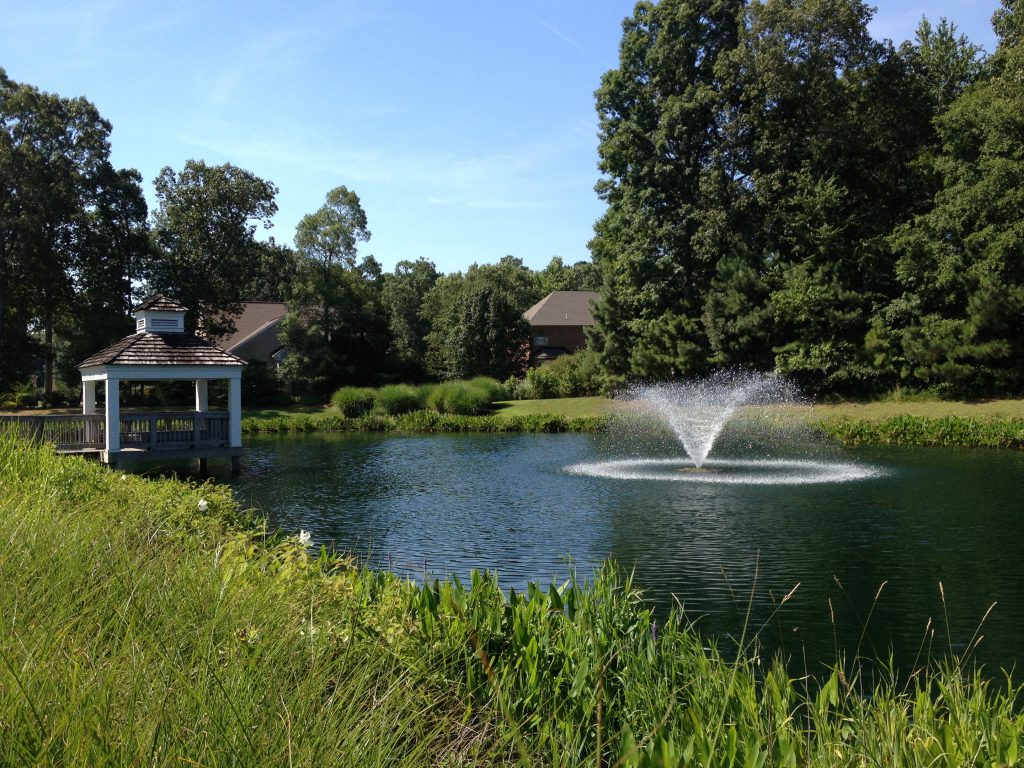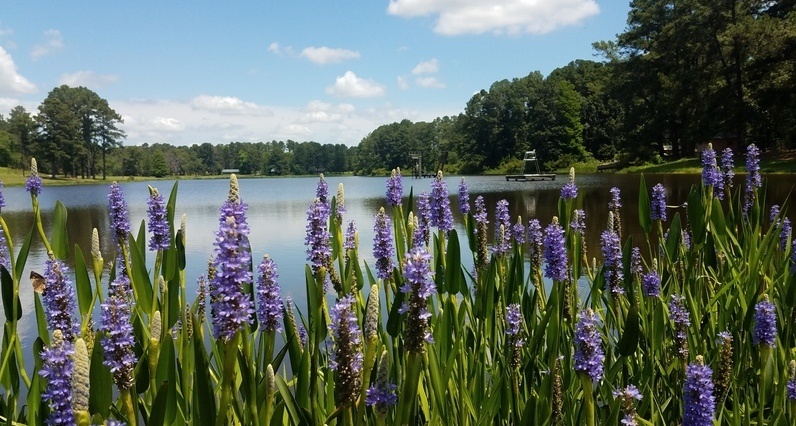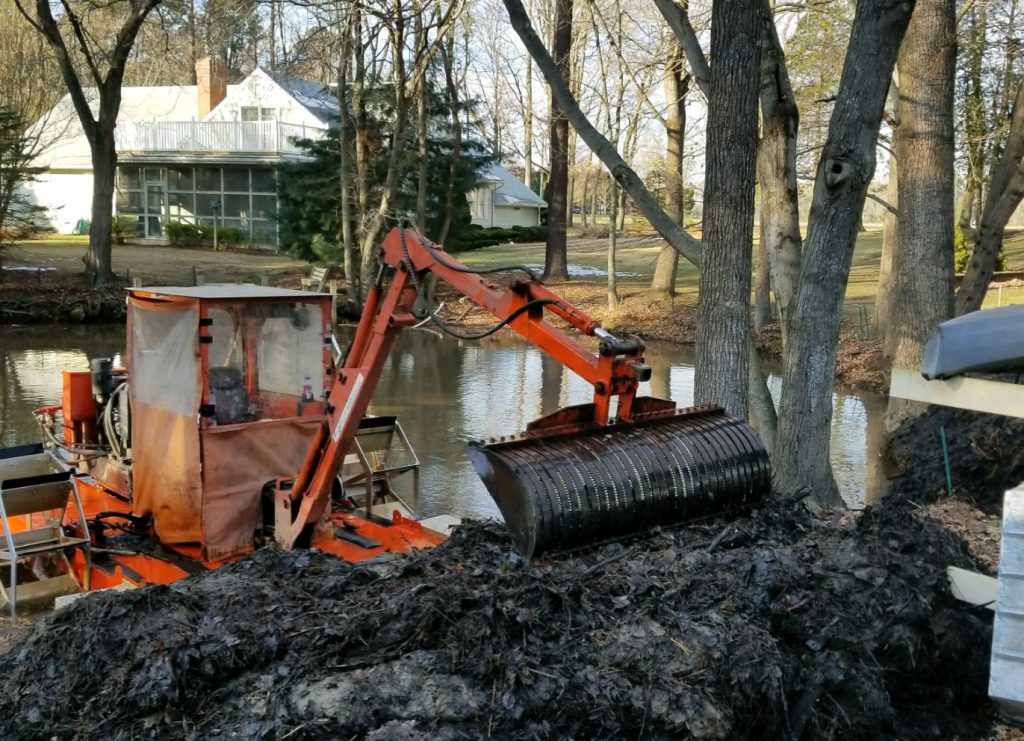
How To Make Your Waterbody A Focal Point In Your Community
Written by: Greg Blackham, Aquatic Specialist
Many homeowners live on a lake or in a community association with several ponds and stormwater facilities. Without proper management, you may find these waterbodies covered in aquatic weeds and algae, or they could simply look like an uninspired waste of space. No matter the condition of your waterbody, one thing is for certain – it should be so much more!
Lakes and ponds provide a multitude of opportunities for recreation, sightseeing, and overall enjoyment of nature, so it can be sad for aquatic specialists when we see this potential go untapped. Luckily, it is never too late to cultivate a stellar focal point in your community. A professional can get you on the right track with innovative modifications and informed management techniques.

Introduce Floating Fountains
One of the first enhancements we recommend for both visual and functional enhancements is a floating fountain. There are two main fountain types: A decorative fountain is designed to spray water into the air in eye-catching spray patterns, though they are generally not relied on for water circulation. Many have brightly-colored (and customizable) lights that draw attention to the waterbody at night. An aerating fountain, on the other hand, is one that is designed primarily for functional purposes, but that doesn’t mean these devices aren’t aesthetically pleasing too. Some of the best-looking aerating fountains combine decorative vertical spray with lower tiers that provide horizontal spray dispersion to effectively circulate the water column below.
Aeration can have many compound benefits when fountain systems are professionally sized and spaced in the waterbody, and in certain instances, it may be beneficial to pair fountains with submersed aeration systems and oxygen saturation technologies. Water movement helps increase dissolved oxygen levels, which in turn helps stabilize pH and inhibits the nutrient pollution that contributes to aquatic weed, nuisance algae, and toxic cyanobacteria growth. Well-circulated and oxygenated water also help prevent mosquito reproduction while supporting healthy zooplankton – small aquatic animals that feed on algae and serve as food for fish and all types of wildlife.

Plant Beneficial Vegetation
Planting beneficial vegetation is a second improvement that should be considered. But before planting anything in or around the water it’s necessary to remove all the noxious and invasive vegetation first, such as cattails, Phragmites (common reed), and purple loosestrife. This helps reduce the risk of collateral damage to newly planted vegetation. It’s best to work with a professional to identify nuisance species and design a removal program, which can vary widely from species to species and might include hand-pulling, burning, or even herbicide applications by drone!
Decorative plants can be used in so many ways to enhance your waterbody. A well-vegetated buffer zone should include a variety of native wildflowers, grasses, and even shrubs that provide a beautiful frame or border around the water. Sometimes, just the contrast alone can make all the difference. There are many other creative ways to plant for color and vibrancy, and a professional lake manager can help assist in the strategic design. In addition to creating a beautiful backdrop, deep-rooted, flowering species can help filter trash and pollutants, protect the shoreline from erosion, and create a sanctuary for wildlife.
Beneficial aquatic plants should also be installed along with the shallow areas of the waterbody for added benefits like serving as a source of oxygen, balancing predator-prey relationships, and filtering nutrients from the water column so they cannot fuel undesirable weeds and algae. One creative installation method could be a floating island of plants and flowers. Floating islands are designed to add color on top and create beneficial bacterial col

Restore Depth And Volume
Another great solution for the almost immediate improvement of a lake or pond is the mechanical removal of polluted sediment, muck, and organic matter from the water. This may be accomplished by a full-on dredging project or through spot treatments via hydro-rake, which is essentially a floating barge equipped with a backhoe that scoops sediment onto the shoreline for disposal.
Shortly after the disturbance has settled there is a significant improvement to water clarity and reduction in bad odors that may exist. More importantly, storage capacity increases. This is crucial for a well-functioning stormwater system that does not flood.

Final Touches And Consistent Maintenance
There are many other improvements that can enhance the beauty of a waterbody without sacrificing functionality. The environmentally friendly blue and black dyes can change the color to a more desirable look, while also reducing available light for weeds and algae. Strategic birdhouses placed around a pond can help reduce midge and mosquito populations in the area while also adding a colorful dynamic to the ecosystem. Even installing a gazebo, a dock, or a small beach area can help break up the landscape and provide more ways for people to engage and interact with their amenities through fishing, kayaking, and birdwatching. Oftentimes, this extra community engagement can spark even larger momentum for creating a truly beautiful and immersive focal point, cherished by everyone that lives there!
Once these efforts have been implemented, they are best maintained through an annual management program, which prioritizes the three central pillars of health, beauty, and functionality. Long-term programs ensure a professional can keep an eye on the multitude of factors that support the ecological balance of the ecosystem, as well as the aesthetic components. Your local aquatic professional can help you design a plan that’s customized to your unique waterbody.
Our Approach To Lake Management
What Questions Can We Answer For You?
Greg Blackham is an Aquatic Specialist and Project Manager at SOLitude Lake Management, the nation’s largest environmental firm specializing in the sustainable lake, stormwater pond, wetland, and fisheries management programs. Learn about this topic and more at www.solitudelakemanagement.com/knowledgebank.
SOLitude Lake Management is a nationwide environmental firm committed to providing sustainable solutions that improve water quality, enhance beauty, preserve natural resources and reduce our environmental footprint. SOLitude’s team of aquatic resource management professionals specializes in the development and execution of customized lake, pond, wetland, and fisheries management programs that include water quality testing and restoration, nutrient remediation, algae, and aquatic weed control, installation and maintenance of fountains and aeration systems, bathymetry, shoreline erosion restoration, mechanical harvesting and hydro-raking, lake vegetation studies, biological assessments, habitat evaluations, and invasive species management. Services and educational resources are available to clients nationwide, including homeowners associations, multi-family and apartment communities, golf courses, commercial developments, ranches, private landowners, reservoirs, recreational and public lakes, municipalities, drinking water authorities, parks, and state and federal agencies. SOLitude Lake Management is a proud member of the Rentokil Steritech family of companies in North America.









